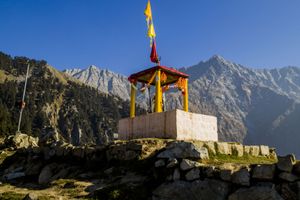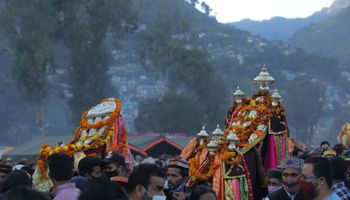Perched on a mountaintop about 7,500 feet above sea level, the Bijli Mahadev Temple is a humble structure with a remarkable history. As an ancient landmark, Hindus regularly pilgrimage to this site between Parvati and Kullu Valleys. Learn more about this "God of Lightning" temple on your next visit to Himachal Pradesh.
Hearing the Legend
This temple was built and dedicated to Lord Shiva who stopped a demon from flooding the Kullu Valley with water from the Beas River long ago. According to legend, the demon Jalandhara was ultimately defeated by Lord Shiva's trident. Afterward, the legend also details the lightning strikes occurring here.
Reportedly, lightning strikes the temple at 12-year intervals. The lightning's power shatters the Shiva lingam or sacred object inside the temple. In response, the temple priest pieces it together with chopad or homemade butter supplied by nearby neighbors and Hindu followers. As a result, the temple's name reflects this unusual occurrence. Indeed, bijli translates to lightning, and Mahadev refers to Lord Shiva.
Understanding the Temple Layout
The Bijli Mahadev Temple reflects its roots in Northern India. First, its architecture has a Kath-Kuni style. This indigenous technique doesn't require mortar for structural connections. Instead, builders simply use stone and wood masonry in strategic layers to create the temple's strong structure. Secondly, the temple has a sanctum sanctorum or holy of holies room. Here, the Shiva lingam resides. With colorful decorations surrounding it, this sacred object attracts visitors from many lands.
Outside, you'll find a 60-foot-tall wooden pole. When lightning strikes, this pole takes the brunt of the power surge. For followers, taking pictures of every temple highlight is part of the experience.
Exploring the Grounds
Generally, the temple is open to visitors from mid-March to mid-December. The temple is relatively small compared to the surrounding grounds. With rolling hills, this landscape explodes with color during the spring. Overall, the best time to visit the Bijli Mahadev Temple is during the late spring or early fall. You'll have easy access to the statues residing outside the temple with moderate weather, too. Typically, the temple opens early and closes late, such as from 5 a.m. to 10 p.m. daily.
Traveling to the Temple
Because of the temple's high elevation, trekking partly to the location is part of the adventure. A popular route starts in the village of Naggar, passes through Jana Village and takes you to the temple's grounds. With a deodar forest and a wildlife sanctuary along the way, this trek is a highlight for visitors.
For visitors traveling from farther locations, take one of three roads to the temple by vehicle. Roads stretch from Parvati Valley, Kullu Valley or Naggar Village. Depending on the weather, the traveling time can vary along with the road's physical conditions. Also, parking fees might be required during certain times of the year.
Camping at the Temple
Naturally, there are no hotels near the temple. Because this landmark is a pilgrimage site, visitors are welcome to camp on the grounds. If you arrive without your camping gear, local vendors rent out supplies nearby.
Alternatively, bring your supplies with you. Pitching tents, starting a bonfire and cooking your food are allowed on the temple grounds. Simply clean up after your group packs up in the morning. Remember to pack for the mountainous terrain, too. Although the spring, summer and fall may have warm days, the nights can be cool at this elevation.
Knowing About Special Events
The Bijli Mahadev Temple can get especially busy during annual festivals. For example, the Shivratri Festival in March can stretch out for three days. During the warmer days in July, a fair for Lord Shiva encourages pilgrimages to this site. Because July is one of the holiest months of the year, this fair is particularly popular for Hindus. Depending on your vacation goals and preferences, you can plan a visit during these celebrations or choose quieter periods during the year.
With the valleys stretching out below the temple, continue your sightseeing with views of the Beas and Parvati Rivers, too. Snapping pictures of the valleys, rivers and surrounding Himalayas is another pastime at this high elevation. From trekking to meditating, visiting the Bijli Mahadev Temple offers unique experiences for everyone in your group.






















